Today we have adapters that we are going to call “3rd Party Intel X710-DA4” quad 10GbE NICs. These are 4x SFP+ NICs that Patrick purchased off of eBay that was being sold under the “Intel X710-DA4” moniker. As we have seen before in Identifying Risky Counterfeit Intel Gigabit CT Network Adapters and Investigating fake Intel i350 network adapters, even the X710 generation has a large set of Ethernet adapters being sold as Intel parts, even if they are not manufactured by Intel.
3rd Party Intel X710-DA4 Quad 10GbE NIC Overview
The Intel X710-DA4 products have two primary form factors. The first one we saw was a full-height variant. Sometime later, we got the low-profile card.
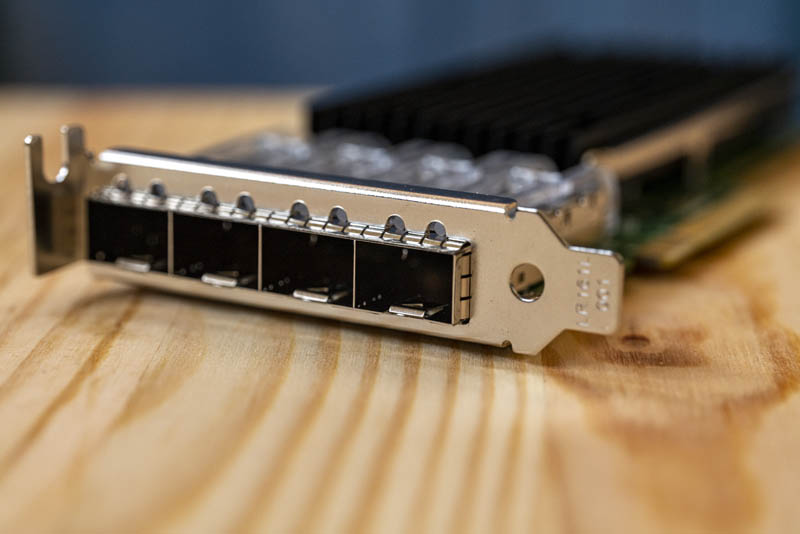
The 3rd party Intel X710-DA4 we are looking at today is a low profile variant.
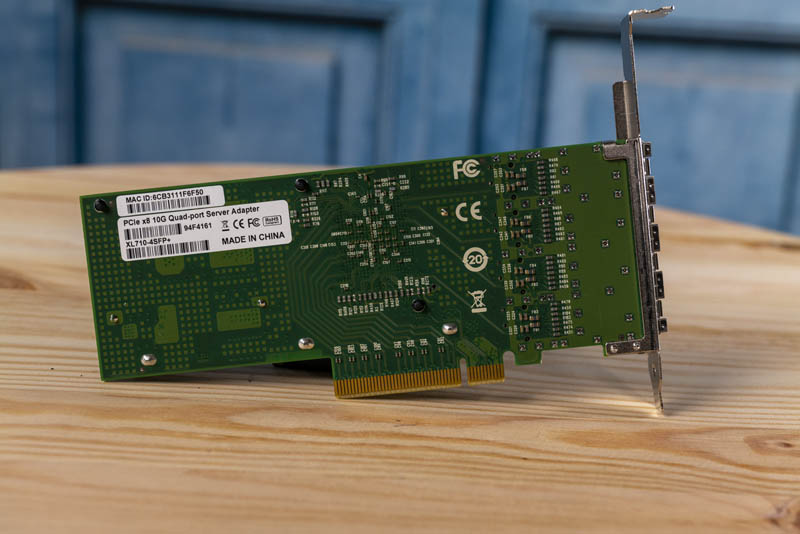
We wanted to take a quick second to show the rear markings of the card. You will notice a few tell-tale signs that these are not genuine Intel cards, or even cards from a major OEM such as Dell, Supermicro, or others. While there are no Yottamark or similar features, the other clue is to look at the FCC, CE, and other markings. If you look at the FCC and CE markings, you will notice that they are different fonts on the PCB and label. Also, on the label this card is marked as a X710-4SFP+. You will note here that while listings for these cards often call them Intel X710-DA4 cards, the adapters themselves are marked with a different part number. These cards are being sold without a company name behind them.
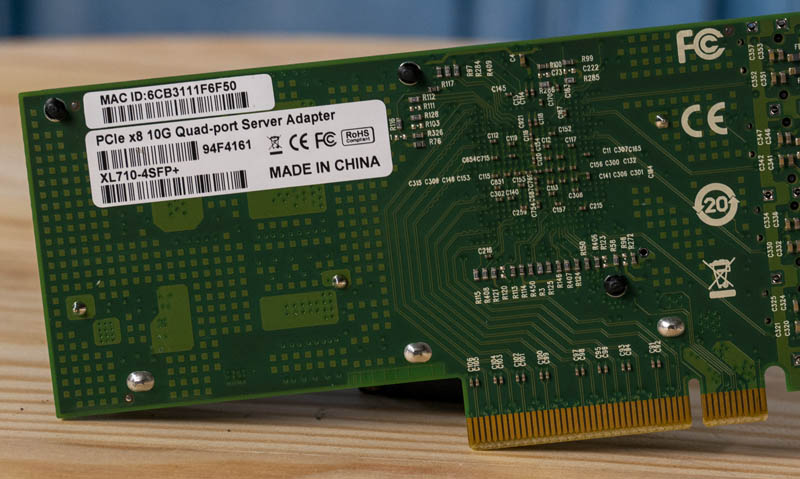
Flipping the XL710-4SFP+ card over, we can see a fairly large heatsink. Most other Fortville generation network adapters have small heatsinks as the NIC itself uses under 7.5W even with four ports pushing traffic. On the genuine Intel version, the X710DA4G2P5 this heatsink is only around 60% as long.
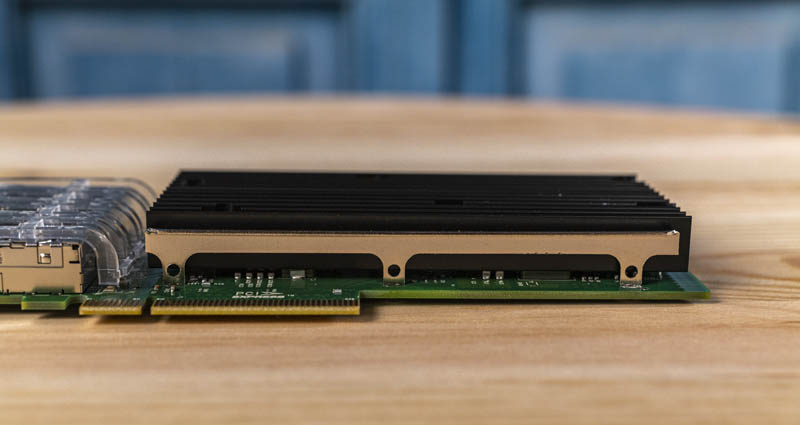
You will see many full-height X710-DA4 adapters on the market. One of the reasons for this is the SFP+ cage layout. The SFP+ cages side-by-side effectively take up the entire width of a low-profile card. We see all of these quad-port SFP+ or SFP28 (25GbE generation) NICs need to use a special mounting bracket solution for their top retention. Many vendors, instead of a screw at the top and one on bottom of the card, use two screws on the bottom and a flange on top to secure the retention bracket.
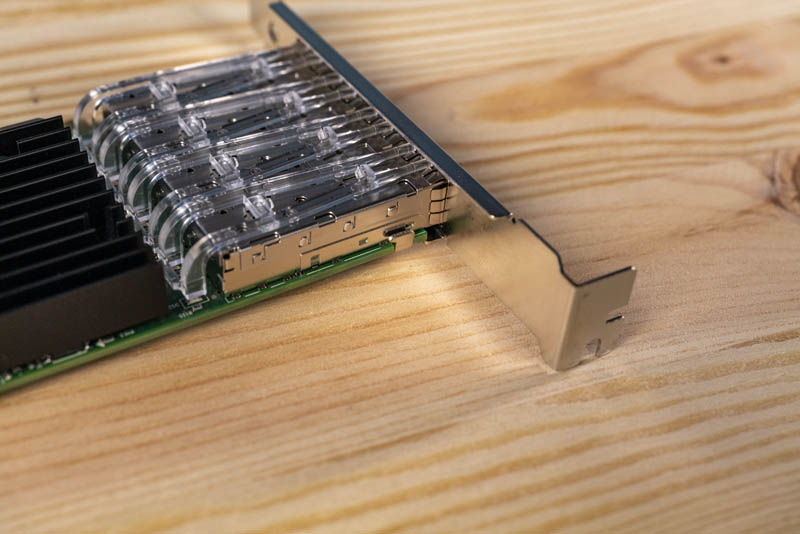
An impact of this tight design is clearance. With the SFP+ cages sticking out beyond the bracket, and the small distance between the SFP cage and the top of the bracket, in many servers these are very difficult to install without damaging the SFP+ cage in low-profile slots. That depends a lot on the expansion slot sheet metal design of your server.
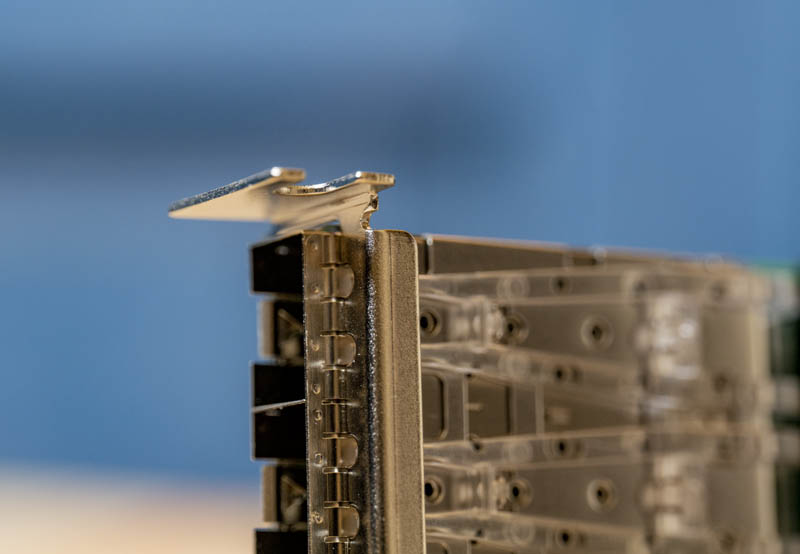
Overall, these cards seem to be built acceptably for $200. That is about half the price of a new Intel branded card. We should also mention that other server OEMs take the X710 chipset and make their own cards so it is not uncommon to see third party or OEM versions of these cards. This just happens to be one that is often marketed as the Intel X710-DA4 even though it is a X710-4SFP+ and the assembly is not made by Intel, just the chip.
For those confused about this versus something like a XL710-QDA2. X is 10GbE. XL is 40GbE. XXV is 25GbE. The last digit is the port count so we have a 4 for this quad-port card. Q is for QSFP+. So we know that while this may be a X710 NIC, the X710-4SFP+ product name on the back of the card is not an actual Intel product.
You can find the key specs of the genuine Intel version here.
3rd Party Intel X710-DA4 Quad 10GbE NIC in Linux
We wanted to take a few moments to show our readers what these NICs look like installed. Here is a look at the lshw output:
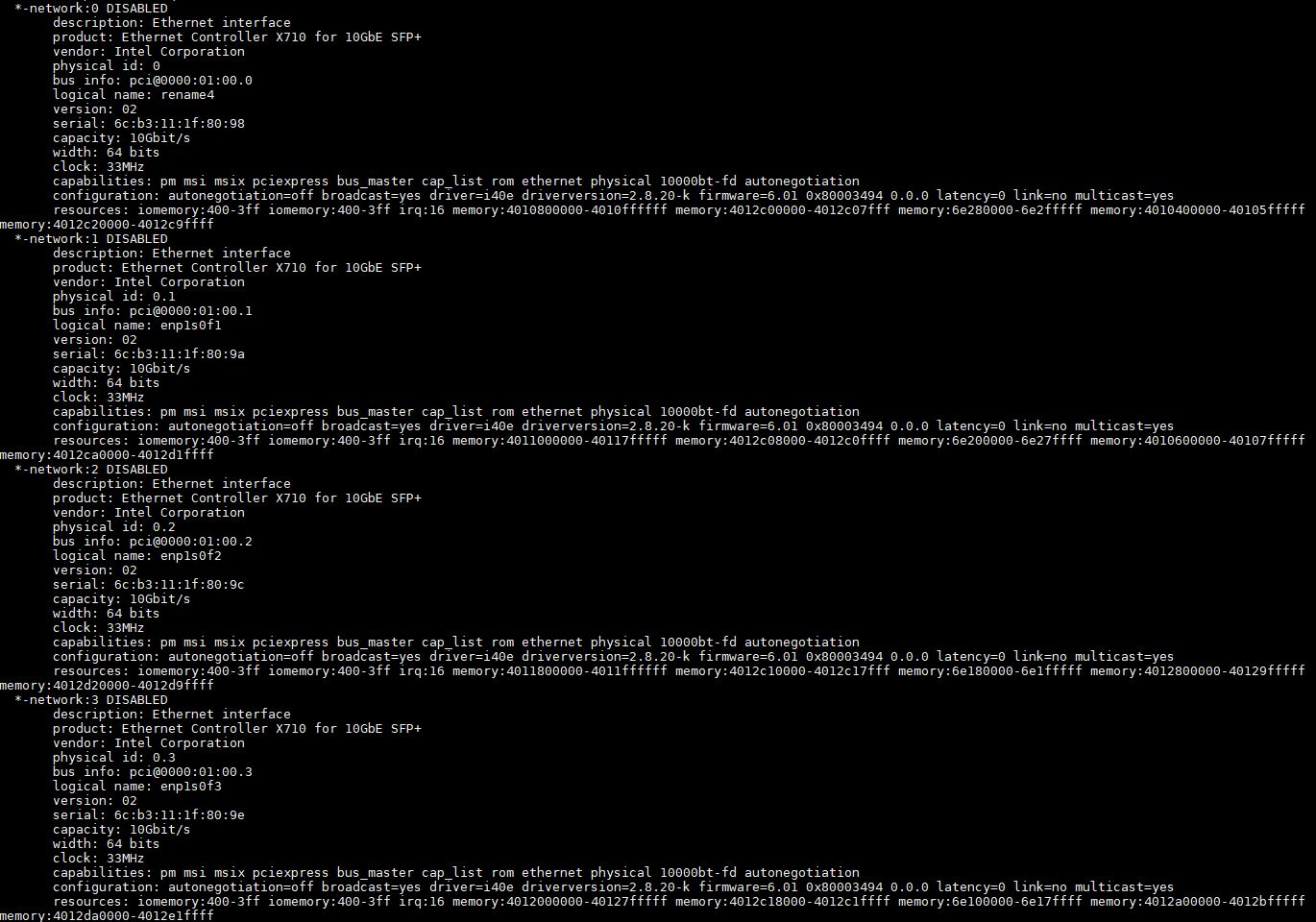
Here is the lspci -vvv output for the NIC:
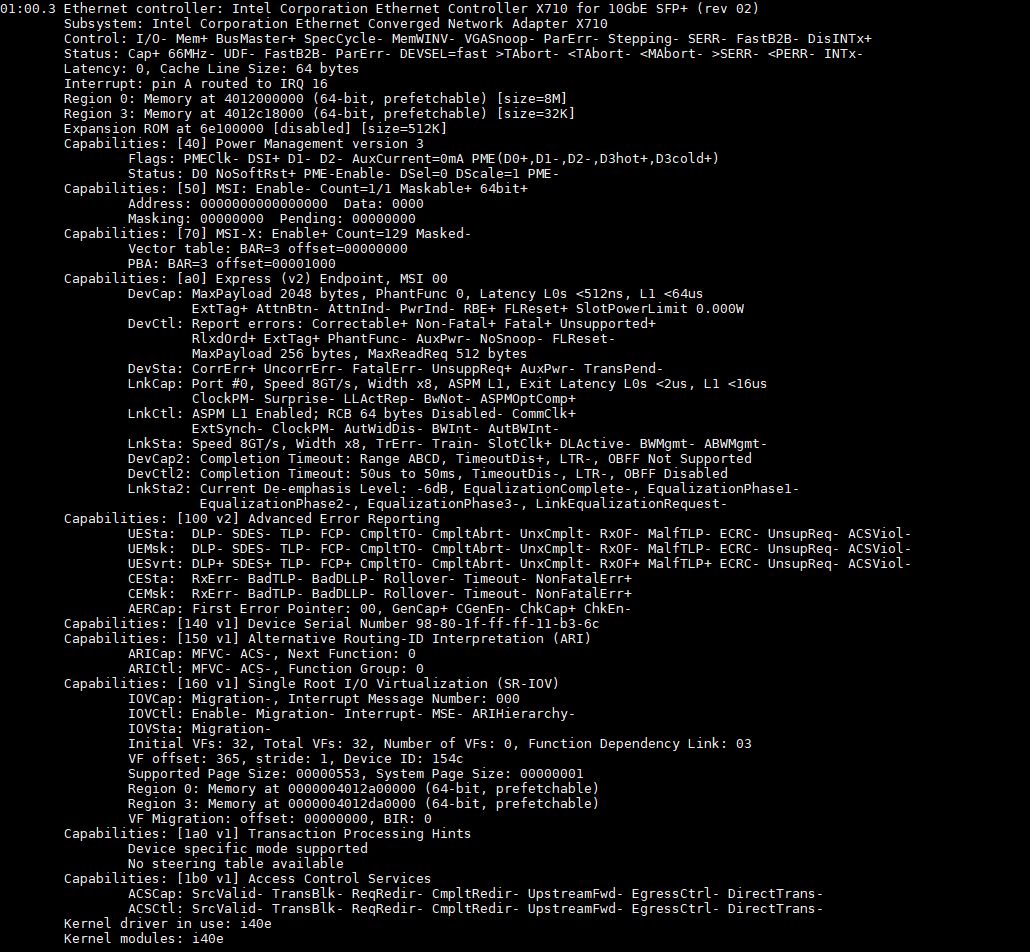
We can see the NICs are using the Intel i40e driver, which is Intel’s mainstream Fortville driver shared with the XL710 series and even the X722 PCH networking options found in Xeon Scalable platforms and the embedded NICs in the Xeon D-2100 series. We can also see SRIOV with 32 virtual functions available.
We are showing Linux here, but this NIC is supported in every major OS.
3rd Party Intel X710-DA4 Quad 10GbE NIC Performance
We tested the X710-4SFP+ using a 1m breakout QSFP+ DAC to our 32-port Arista 40GbE data center switch. We then varied the port speed and connection type and tested transfer speeds from our network storage.
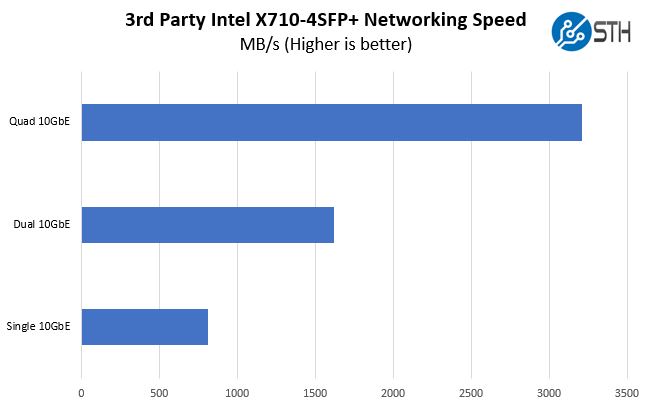
We also tried 10GbE SFP+ direct links to our QCT QuantaMesh T3048-LY8 both cases worked and showed the same performance within 0.5% which is a test variation. You will need a PCIe Gen3 x8 slot in order to drive four ports of 10GbE.
A quick word on power consumption, we only got this unit up to 7.0W. It is rated to go up to 7.5W for the standard Intel card.
Final Words
Overall, this card worked well. We actually purchased three of these cards and have them running in servers. Our goal is to report back if we see anything strange. We also are going to come back and update this piece if we see anything strange happen with these cards over the next 36 months.
There are multiple risks to using these cards. Without even a manufacturer name, the realistic chance to have any warranty support is very low a few months down the line. That also means there is no company that is standing behind the security of the supply chain. It is and should be, scary to some that a device like this can be put into a network and connected without having any guarantee of the supply chain making this card.
On a practical level, the Fortville Intel Ethernet 700 series is very well supported in every major OS and hypervisor at this point. Unlike the Marvell-based HPE 620QSFP28 we reviewed, this adapter worked in FreeBSD, Linux, and Windows out-of-the-box. The NICs did come with a driver CDROM. Our practice is to immediately discard that CDROM and just use drivers downloaded from Intel for updates.
We found this card to be extremely permissive with what SFP+ modules it took. There appears to be no module encoding enforcement as we find on many genuine Intel cards. There are many places in the world where a $200 card that can use virtually any SFP+ module is better than a $400 card that requires vendor-specific encoding. Of course, with no manufacturer standing behind the X710-4SFP+ / 3rd party Intel X710-DA4 cards even putting their name on them, these features could change even batch by batch.
If you are OK for the risks, frankly these work acceptably. That is probably why they are pervasive in online marketplaces. We just wanted to show this adapter off so that if you see this type of adapter you know what it is and understand that it is not a genuine Intel manufactured card.

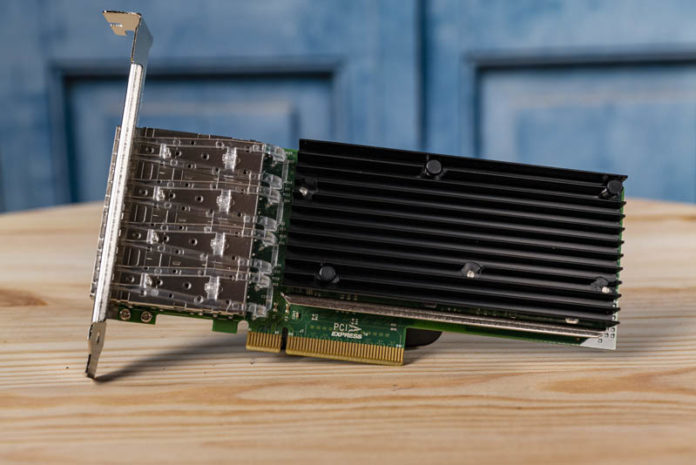



Thanks! Please more of those articles. As you said, those no labeled cards are everywhere, so your reporting does help to bring some factual experience on which we customers and users can judge them!
Greetings
We bought these late 2019 thinking they’re genuine Intel. Thanks for spreading the word. It isn’t mentioned in this review, but that heastink has metal that goes through the heatsink and PCB so you can’t see underneath the heatsink.
Does anything on this site ever get less than 9? This fake card is given an 8.8.
If everyone is a winner, then no one is.
Bob they had a 7.8 just a week ago https://www.servethehome.com/silicon-power-128gb-a55-m-2-sata-ssd-review/ right?
These also aren’t “fake” cards. The chipset is still Intel and they’re not marked “Intel” and not marked “X710-DA4” on them. You’ve got to understand that not everywhere has access to the same cards people in EU and USA do
That’s a great point you’re making TH. I know there are countries where we can get these cards but we can’t get standard cards anywhere near reasonable.
BD I went back two weeks and less than half of the products got a 9.0 or higher, even this one didn’t. It’s hard to imagine anyone could even sell a 6 rated product, right?
I enjoy that STH doesn’t do every junk part, does these that we’re likely to encounter, and has a global perspective. I know that’s hard with STH being in the USA but they’re doing a real good job at it.
They have addressed that issue before, STH don’t go out of their way to review rubbish products because it would be a waste of time. If your fairly confident that everything you pick to review is going to be good it doesn’t really do any good to try and achieve an average score of a 5 as it will make people think that something is rubbish when in reality if you compared it to the whole market it would score high.
Supermicro offers this card if you need the support something-i4s iirc.
One should note that these NICs most likely contain a genuine Intel Forville ASIC, it’s just the PCB and other components that are made by a 3rd party. There is nothing wrong with this per se, however it is misleading that they are using the Intel Model number and not listing a manufacturer promenantly.
Having said that, Intel definantly sells just the ASIC so that other ODM/OEM manufacturers can place them on their own boards, be it a standard form factor, LOM, blade, etc…
The NIC you are reviewing is made by Shenzhen Lianrui Electronics Co.,Ltd, a.k.a. LR-Link. It can be found here: http://www.lr-link.com/products/LREC9804BF-4SFP_.html. Their MAC address is a give away. Note the offical product listing has a different set of stickers on the back but otherwise the same PCB. You’ve got a generic sticker, either by them directly using a different SKU intended for the amazon/ebay market or rebadged by someone else.
You’ll note that the pictures in the product listing have a slightly different sticker placement. Your one is most likely covering the LR-LINK etching in the back metal layer. My bet is if you removed the sticker it would reveal the PCB manufactor and confirm it’s origin.
I’ve had this card for a few years now, I’ve even applied a few of the Intel (critical?) NVM firmware updates available for it. It ran fine in an ESXi box, one thing I did notice, under Win 10 it takes 3-5 minutes, or what I recall as forever to actually acquire an IP address upon boot.
I can’t remember what told me to upgrade the firmware on it, it’s on the shelf at the moment waiting for the next server…
Does this work with Windows 8.1?